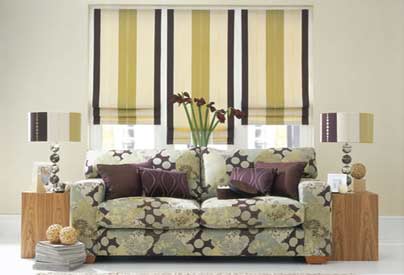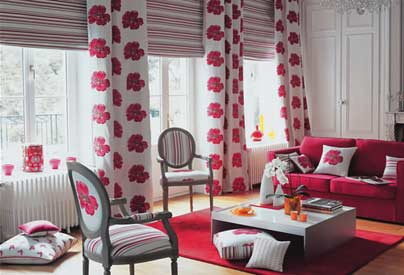Fashion for windows
Do you still have a pair of sheets hanging in over the rail in your living room simply because you can’t decide whether you should spring for custom shades or buy some off-the-shelf curtain panels?
Here are some tips to get you on the right track...
Dressed to impress
Unless you own a mansion of stately proportions, you want guests to admire your window treatments as a whole, not point to the ends of your curtain rod where you have placed giant carved acorns! Finials should be an integral part of the drapery design rather than an afterthought.
Make a statement
Window treatments allow you the opportunity to add colour and texture to a room, and by mixing fabrics you can add even more visual interest. Think out of the box when it comes to your window treatments - think saris, silk, velvet and brocade. Keep an eye on the fashion catwalks to see what's hot and what's not!
Say no to minis
If you’re out cruising the aisles at your local fabric store and you see the pattern of your dreams for your living room windows, make sure to buy enough fabric to fit the window. Window treatments generally have pleats, folds or fullness, and for this you usually need two to three times the width of the window. Plus, you have to enough fabric for the top and bottom hems, which should be generous. And don't forget that if you are using a pattern that is repeated on the fabric, you need extra fabric to be able to match the pattern at the seams.
Top off the ensemble
Hardware is part of the overall look of your draperies. If you’ve gone to the trouble to have someone make the perfect drapes, don’t skip on what holds them up! The curtain rod is very important.
When you see a rod up close, you might think it looks big with the finial. Well, if the drapes in your formal dining room are 3 metres long, and you’ve chosen an 3cm-wide rod with tiny finials at each end, by the time you get the curtain rod on the wall, it’s going to look dinky. You often have to buy bigger rods and finials than you imagine to balance out a big, formal drape. Proportions are important.
Designer trends
Today’s window dressing styles are endless: vertical or horizontal, cellular shades, fabric or wood blinds, etc. Window treatments have gone from simply dressing the window to a designer style that is as individual each home.
High fashion
If you live in a high-ceilinged loft or have a long wall of windows, you need to choose a drapery hardware system that allows the drapes to hang and function properly. In this case a track system is better than a rod system. With most rods, you can’t go more than a metre or two without a wall-mounted bracket. Large windows need to have hardware that can go higher without an interruption.
Tailored to your style
Not everyone loves drapes. There are those that prefer the more tailored look of shades or blinds. When drapes are open, not only can they hide architectural features such as window frames, but the beautiful design of the fabric is lost in all the folds.
Shades and blinds provide a cleaner line and allow you to see features rather than fabric, or show a pattern more dramatically than a curtain can. If you have an older or mid-century home, you may be seeking a window treatment for short windows. Most windows used decades ago were not as expansive as the panes of glass seen in modern construction. The reasons for this were cost as well as logistical concerns. Large panes of glass were simply not supported in older construction methods.
Now, it is up to creative homeowners and designers to come up with an innovative window treatment for short windows. Sometimes, the best ideas are the simplest ones. A window treatment for short windows need not be complicated to address the issue at hand and make the most of the window. One idea is to use materials that completely cover the window, so that the casual observer believes the window to be larger than it actually is. Consider installing long shades that hang well below the short window.
A flat or hobbled roman shade will make an excellent statement, and it can be pulled up when light is desired. When the roman shade is down, it will appear that the window is the same size as the shade on top. An option to the soft fabric roman shade is a bamboo shade or woven wood shade – both of which have a wonderful, rich texture. These are semi-translucent, so the outline of the small window may show during the day. A privacy or blackout lining can be added to minimise this effect.
A different approach to tackle a window treatment for short windows is to use a café curtain on a decorative wood or iron rod. This type of curtain only covers the lower part of the window, leaving the top open for maximum light and view. Because of this factor, it is mostly appropriate for rooms where privacy is not an issue. The standard café curtain is hung about midway on a window, but you could hang it a little lower and let the rest of the curtain extend the length of the window as far down as you like. It is also a good idea to think about some design tips which can help lighten a dark room with small windows.
Unique Ideas for Short Windows
Instead of trying to cover up the problem, you can opt to accentuate the windows. Play up a window treatment for short windows by installing elaborate or colourful stained glass panels which will capture the light in fascinating ways. Since this option can get pricey, you can also look into faux stained glass or window film that looks like the real deal. Use paint and a stencil (or hire a decorative painter) to add even more drama, colour, and flair around the window frame.
Another interesting option is to use window inserts made of wrought iron or carved wood. This idea will require a very handy person or the services of a craftsman who can create a custom, built-in design.




